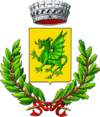Saltara
| Saltara | ||
|---|---|---|
| Comune | ||
| Comune di Saltara | ||
| ||
 Saltara Location of Saltara in Italy | ||
| Coordinates: 43°45′12.35″N 12°53′51.36″E / 43.7534306°N 12.8976000°E | ||
| Country | Italy | |
| Region | Marche | |
| Province / Metropolitan city | Pesaro e Urbino (PU) | |
| Frazioni | Borgaccio, Calcinelli | |
| Government | ||
| • Mayor | Fabio Cicoli | |
| Area | ||
| • Total | 9.97 km2 (3.85 sq mi) | |
| Elevation | 160 m (520 ft) | |
| Population (February 2009)[1] | ||
| • Total | 6,715 | |
| • Density | 670/km2 (1,700/sq mi) | |
| Demonym(s) | Saltaresi | |
| Time zone | CET (UTC+1) | |
| • Summer (DST) | CEST (UTC+2) | |
| Postal code | 61030 | |
| Dialing code | 0721 | |
| Patron saint | St. Sebastian | |
| Saint day | 20 January | |
| Website | Official website | |
Saltara is a town in the province of Pesaro e Urbino, Marche, central Italy. It is on a 120-metre (390 ft) hill overlooking the lower Metauro valley.
Before World War II Saltara was a center of pallone col bracciale playing.
Main sights
- Remains of the medieval castle
- Former church of Fonte (1595)
- Sanctuary of Madonna della Villa
- Convent of San Francesco di Rovereto
- Science Museum of Villa del Balì
Twin towns
 Police nad Metují, Czech Republic
Police nad Metují, Czech Republic Bietigheim, Germany
Bietigheim, Germany Caumont-sur-Durance, France
Caumont-sur-Durance, France
References
This article is issued from Wikipedia - version of the 5/31/2015. The text is available under the Creative Commons Attribution/Share Alike but additional terms may apply for the media files.

